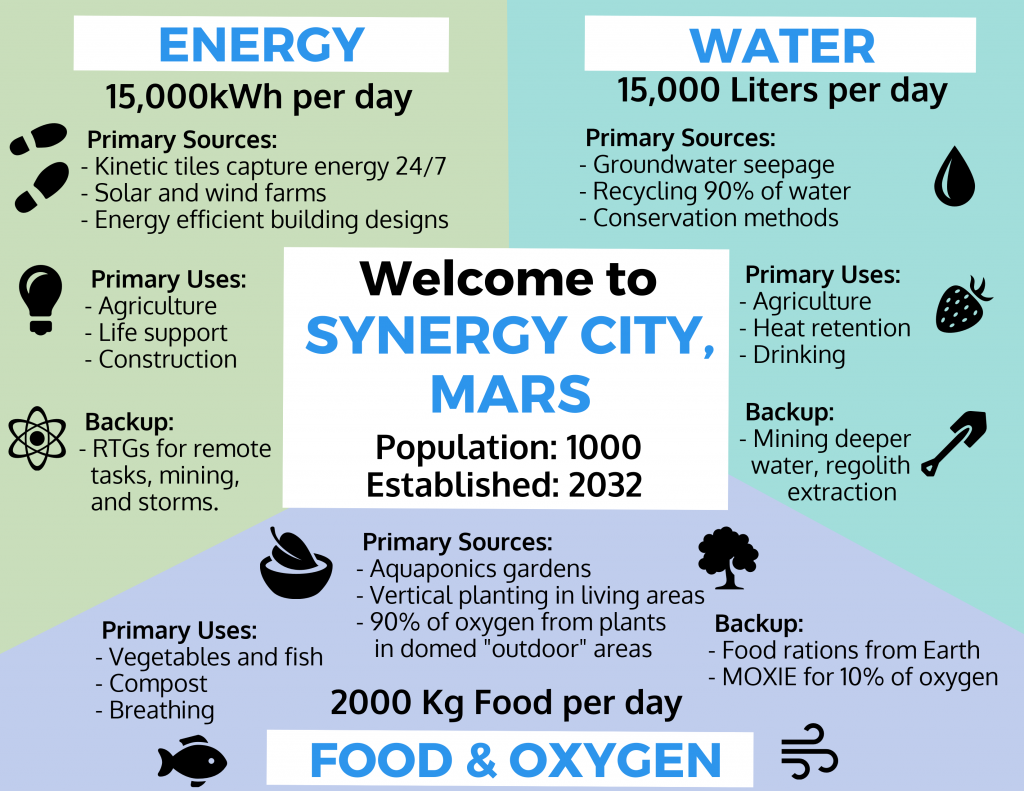How to Survive on Mars
So I just finished my free online class How to Survive on Mars, and I gotta say, colonizing the red planet is looking pretty doable. Life will be a lot different than it is here on Earth, but it seems like Mars possesses all the ingredients for hosting life. My focus on the class was trying to find ways to work with the environment–thinking like a Martian, if you will–and not trying to import a bunch of Earthling ideas to our future colonies.
Here’s my final concept map covering the four bare necessities for survival on Mars: Water, Energy, Food, and Oxygen.
ENERGY:
Mars gets less than half of the sunlight we do on Earth, and although there are many dust storms, wind power is limited due to low atmospheric pressure, however, both of those methods would be great sources of energy when coupled with these kinetic tiles I found online. Assuming our colony would be operational 24/7, people power could serve as the primary source of energy for the colony, without relying on external environmental factors. The tiles are still a relatively new technology, but already boast 1-7 watts per step. The average colonist could easily produce 7 kilowatts of energy per day, multiplied by 1000 people would be 7,000 kilowatts per day, or nearly half of the energy needed by the colony per day, certainly more than enough to run basic life support, provide lighting for agriculture, and to operate computer systems.
WATER:
The interplanetary postage on shipping water is cost prohibitive, and yet water is essential to survival on Mars. Fortunately, Mars has tons of it, at the ice caps obviously, but also underground, as evidenced by water seepage from several sites near the equator. Setting our colony near one of these sites would offer us balmy summer temps (at least during the daytime) to reduce the need for heating. If we capture this seepage before it sublimates (water boils off in the low atmosphere) we would have enough water for drinking, bathing, and growing crops. Water conservation and recycling would also be essential, and minimize the amount of effort needed for collection activities.
FOOD & OXYGEN
These two are hard to separate, since with all of the leafy green food that needs to be grown to feed the colony, we also get the side benefit of producing oxygen. Traditional farming requires about an acre to feed one person, and lots of irrigation. Feeding 1000 sounds like it would take a lot of water and space, but if we institute a self-contained aquaponics system, most of the food could be grown vertically, using minimal amounts of water, and using the nitrogen from aquarium fish waste to provide plants with nutrients. Freight Farms has a setup now that can feed 4 people in the space of a 40-foot truck trailer. Half of the colony’s food would be grown within enclosed domes that mimic an “outdoor” feel, while the other half would be in a separate, self-contained area to ensure we don’t encounter problems with too much oxygen in our living spaces.
BACKUP SYSTEMS:
Of course, backup systems would need to be in place in case things go wrong. I envision RTGs (radioisotope thermoelectric generators) such as the plutonium-powered devices that the rovers on Mars use now. They don’t produce a lot of energy, but could be used for remote applications, and recalled when there are dust storms to provide emergency power in a pinch. I think with smart building designs, we can avoid the need for actual nuclear power, though many people in my class were proponents of using it. We could also mine deeper for water if needed, or extract it from Martian soil (regolith contains about 3% water.) For food, we’ve always got astronaut ice cream, if we find ourselves in a pinch. Plus it’d be nice to have some delicacies that are only available from Earth once in a while.
IN SUMMARY:
This was a really great class, but like all learning opportunities, you get out of it what you put into it. I spent a lot of time plotting and planning and playing around with ideas for surviving while doing as little as I could to disturb the Martian land around us. For me this was a lot like world building, but without the pressure of having to write a book afterwards…though now, I totally feel like I could. I’d definitely recommend the class, for those new to Mars or writers looking to put a little extra “science” in their science fiction.
Mars, we’re packing our bags.
See ya soon!

